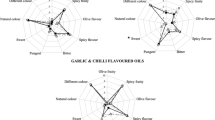Abstract
The extraction conditions of virgin olive oil have a great influence on its sensory quality. During the centrifugation process, temperature and time of malaxing can be altered to potentially affect quality. Malaxing times (15, 30, 45, 60, and 90 min) and temperatures (25 and 35°C) were studied in an experimental oil mill. Volatile compounds, produced through the lipoxygenase pathway (hexanal, Z-3-hexenal, E-2-hexenal, hexyl acetate, Z-3-hexenyl acetate, hexan-1-ol, E-3-hexen-1-ol, Z-3-hexen-1-ol, and E-2-hexen-1-ol), were analyzed by dynamic headspace gas chromatography, gas chromatographymass spectrometry, and gas chromatography-olfactometry. Different amounts of volatiles responsible for positive attributes of green aroma and negative attributes of astringent mouthfeel of virgin olive oil were determined. The results, after applying mathematical procedures, showed that a temperature of 25°C and a malaxing time between 30 and 45 min produced volatile compounds that contribute to the best sensory quality. High temperature (T≥35°C) with minimum values of time (t<30 min) could also be useful as an alternative way to obtain pleasant green virgin olive oils.
Similar content being viewed by others
References
Aparicio, R., M.V. Alonso, M.T. Morales, and J.J. Calvente, Relationship Between COI Test and Other Sensory Profiles by Statistical Procedures, Grasas Aceites 45:26–41 (1994).
Aparicio, R., and M.T. Morales, Sensory Wheels: A Statistical Technique for Comparing QDA Panels. Application to Virgin Olive Oil, J. Sci. Food Agric. 67:247–257 (1995).
Flath, R.A., R.R. Forrey, and D.G. Guadagni, Aroma Components of Olive Oil, J. Agric. Food Chem. 21:948–952 (1973).
Morales, M.T., M.V. Alonso, J.J. Rios, and R. Aparicio, Virgin Olive Oil Aroma: Relationship Between Volatile Compounds and Sensory Attributes by Chemometrics, Ibid.:2925–2931 (1995).
Morales, M.T., J.J. Calvente, and R. Aparicio, Influence of Olive Ripeness on the Concentration of Green Aroma Compounds in Virgin Olive Oil, Flavour Fragr. J. 11:171–178 (1996).
Guth, H., and W. Grosch, A Comparative Study of the Potent Odorants of Different Virgin Olive Oils, Fat. Sci. Technol. 93:335–339 (1991).
Guth, H., and W. Grosch, Quantitation of Potent Odorants of Virgin Olive Oil by Stable-Isotope Dilution Assays, J. Am. Oil Chem. Soc. 70:513–518 (1993).
Solinas, M., V. Marsilio, and F. Angerosa, Evoluzione di alcuni componenti dell’aroma degli oli vergini di oliva in relazione al grado di maturazione delle olive, Riv. Ital. Sost. Grasse 44:475–480 (1987).
Morales, M.T., R. Aparicio, and J.J. Rios, Dynamic Headspace Gas Chromatographic Method for Determining Volatiles in Virgin Olive Oil, J. Chromatogr. 668:455–462 (1994).
Di Giovacchino, L., F. Angerosa, and L. Di Giacinto, Effect of Mixing Leaves with Olives on Organoleptic Quality of Oil Obtained by Centrifugation, J. Am. Oil Chem. Soc. 73:371–374 (1996).
Aparicio, R., M.T. Morales, and V. Alonso, Relationship Between Volatile Compounds and Sensory Attributes of Olive Oils by the Sensory Wheel, Ibid.:1253–1264 (1996).
Bedoukian, P.Z., The Seven Primary Hexenols and Their Olfactory Characteristics, J. Agric. Food Chem. 19:1111–1114 (1971).
Vick, B.A., and Zimmerman, D.C., Oxidative Systems for Modification of Fatty Acids: The Lipoxygenase Pathway, in The Biochemistry of Plants: A Comprehensive Treatise, edited by P.K. Stumpf and E.E. Conn, Academic Press, New York, 1987, Vol. 9, pp. 53–90.
Hatanaka, A., T. Kajiwara, and J. Sekiya, Biosynthetic Pathway for C6-Aldehydes Formation from Linolenic Acid in Green Leaves, Chem. Phys. Lipids 44:341–361 (1987).
AIR, European Project AIR3-CT94-1967, Olive Oil Flavor and Aroma: Biochemistry and Chemistry of Sensory Factors Affecting Consumer Appreciation and Their Analysis by Artificial Intelligence, The Commission of the European Communities, 1994, pp. 17–23.
Di Giovacchino, L., and A. Serraiocco, Influenza dei sistemi di lavorazione delle olive sulla composizioni dello spazio di testa degli oli, Riv. Ital. Sostanze Grasse 72:443–450 (1995).
Ranalli, A., and A. Serraiocco, Evaluation of Characteristics of Olive Oil Produced by Innovative and Traditional Processing Technologies, Ibid.:303–315 (1996).
Frias, L., A. Garcia-Ortiz, M. Hermoso, A. Jimenez, M.P. Llavero, J. Morales, M.T. Ruano, and M. Uceda, Analistas de Laboratorio de Almazara, Andalusian Ministry of Agriculture, Sevilla, 1993, pp. 19–22.
Humanes, J., Producción de Aceite de Oliva de Calidad: Influencia del cultivo, edited by Junta de Andalucía, Consejería de Agricultura y Pesca, Seville, 1993, p. 139.
Galliard, T., Degradation of Acyl Lipids, Hydrolytic and Oxidative Enzymes, in The Biochemistry of Plants, edited by P.K. Stumpf and E.E. Conn, Academic Press, London, 1980, Vol. 4, pp. 85–116.
Aparicio, R., and M.T. Morales, Optimization of a Dynamic Headspace Technique for Quantifying Virgin Olive Oil Volatiles. Relationships Among Sensory Attributes and Volatile Peaks, Food Qual. Pref. 5:109–114 (1994).
Hatanaka, A., T. Kajiwara, H. Horino, and K. Inokuchi, Odor-Structure Relationships in n-Hexenols and n-Hexenals, Z. Naturforsch. 47c:183–189 (1992).
Statsoft, Statistica release 5, Tulsa, 1995.
Grosch, W. Determination of Potent Odourants in Foods by Aroma Extract Dilution Analysis (AEDA) and Calculation of Odour Activity Values (OAVs), Flavour Fragr. J. 9:147–158 (1994).
McEwan, J.A., Consumer Attitudes and Olive Oil Acceptance: The Potential Consumer, Grasas Aceites 45:9–15 (1994).
Pagliarini, E., M. Bertuccioli, and S. Abbà, Consumer Attitudes and Olive Oil Acceptance: The Traditional Consumer, Ibid.:16–19 (1994).
Official Journal of the Commission of the European Communities, March 28, 1995, pp. 3–4 Regulation n°1 656/95.
Aparicio, R., J.J. Calvente, M.V. Alonso, and M.T. Morales, Good Control Practices Underlined by an On-Line Fuzzy Control Database, Grasas Aceites 45:75–81 (1994).
Author information
Authors and Affiliations
Corresponding author
About this article
Cite this article
Morales, M.T., Aparicio, R. Effect of extraction conditions on sensory quality of virgin olive oil. J Amer Oil Chem Soc 76, 295–300 (1999). https://doi.org/10.1007/s11746-999-0234-9
Received:
Accepted:
Issue Date:
DOI: https://doi.org/10.1007/s11746-999-0234-9




